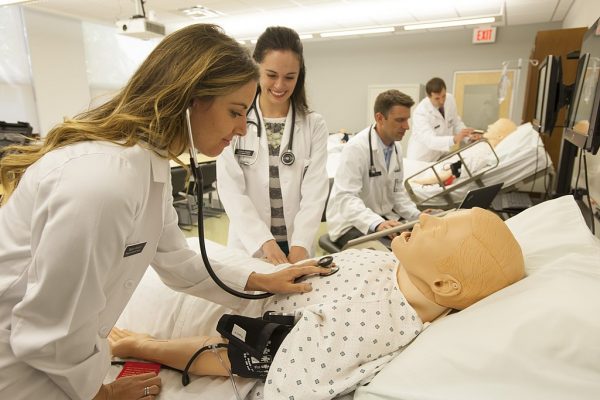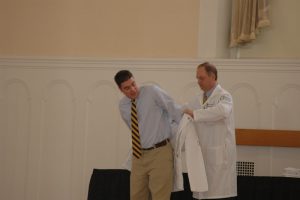
Medical sociologists Tania Jenkins (PhD, University of North Carolina-Chapel Hill) and Elaine Hernandez (PhD, MPH, Indiana University) pair up in this four-part series, COVID-19: Dispatches from Medical Sociology, to provide insight on how the current COVID-19 pandemic is changing the landscape of American healthcare. In the second segment, Jenkins and Hernandez cover the challenges facing medical education.
- Social Inequities in Healthcare
- The Doctor Will “See” You Now
- Changing Dynamics within Healthcare Professions
- The Challenges Facing Medical Education
—
The Challenges of Medical Education
Training in a time of heroism and martyrdom
The COVID-19 pandemic has reshaped education for millions of students — including the thousands who are training to become physicians. Medical students, residents (who complete 3-7 years of postgraduate training after medical school), and fellows (who have completed residency and are further subspecializing) are all adapting as health care systems grapple with providing care.
Medical students have largely been working from home. On March 17, 2020, the Association of American Medical Colleges (AAMC), representing major U.S. medical schools and teaching hospitals, “strongly suggest[ed] that medical students not be involved in any direct patient care activities.” Instead, first- and second-year medical students have been taking didactic classes online. Third- and fourth-year medical students have either had to postpone in-hospital rotations by taking electives, or take their rotations online. Shifting online has left some students feeling underprepared for their final exams at the end of each rotation — they may not have encountered diseases on which they are being tested. “Away” rotations, where students get to practice at other hospitals and “audition” for competitive residency positions, have been suspended by the AAMC until at least early May. Even certain licensing exams have been put on hold, raising questions about whether current students will be able to complete their degree requirements in time to graduate.

The situation is reversed for fourth year medical students, many of whom are already being called into full-time work. Medical students about to graduate have seen their timelines to graduation accelerate in recent weeks. Over 13 medical schools have agreed to let students graduate early in response to government pleas for more healthcare workers. One such school is New York University, where 35 out of 122 fourth-year medical students agreed to work as temporary residents in internal medicine at NYU Langone Medical Center from mid-April until the end of June.
But as these early medical school graduates start working, it will not be “business as usual” in most teaching hospitals. Some residents and fellows are being “redeployed” from their usual specialties to the general medical floors and intensive care units, raising questions about how these interruptions might interfere with their own training or time to completion. Trainees must contend with feelings of isolation, fear, anxiety, and powerlessness, not to mention the physical discomfort of constantly wearing PPE (when they can acquire it). And many are working themselves to exhaustion, including in New York State, where the governor lifted the 80-hour workweek restriction for residents as part of a comprehensive Executive Order aimed at increasing healthcare capacity.
The result is that many brand new physicians are currently walking a fine line between heroism and martyrdom. As a society, we have long expected physicians to put our care and comfort before their own. And for the most part, physicians have internalized and amplified those expectations, by coming to work even when they are sick, by avoiding care themselves, and hiding signs of mental illness.
But are we expecting too much from physicians, especially the trainees? How might some of these new policies, like early graduation, reinforce the already superhuman expectations we have of physicians? Both the AMA and the AAMC have made clear that medical students should not be coerced into direct patient contact, even as society clamors for more doctors. But some institutions, like Harvard, have already come under criticism for asking medical students to put themselves at high risk with little reward by appealing to their sense of duty (On April 20, Harvard Medical School sent an email to fourth-year medical students inviting them to volunteer at a local COVID-19 hospital without pay or benefits).

Meanwhile, healthcare providers are being hailed as heroes right now, and for very good reason. Talk of heroism, however, combined with professional pressures to be selfless may inadvertently set trainees up for failure, as they struggle to embody unrealistic expectations. Experts already warn of a “double whammy” as COVID-19’s psychological toll exacerbates already high rates of burnout in medical professions, in what could become the virus’ “fourth wave.” If we want to protect the health of our medical workforce, we need to cut them some slack.
We offer three evidence-based policy recommendations for keeping the workforce healthy and effective during the pandemic and beyond. These recommendations are based, in part, on work by Jenkins on physician burnout and from the emerging subfield of the sociology of medical education (learn more about the sociology of health professions and medical education community of scholars here). First, professional norms need to change through structural interventions aimed at making it more acceptable for trainees (and their superiors) to show when they’re struggling. The normal “rules” for being a good physician are being upended right now, as students are being thrust into a healthcare system in crisis. The pandemic may therefore represent an opportunity to model healthier behaviors for trainees moving forward.
Second, given the significant need for physicians, Congress should act now to increase the number of federally-funded residency positions, which have been capped since 1997. Capping these positions helps maintain the value of a U.S. medical education by restricting the number of U.S.-trained doctors being produced, but it overworks current residents instead of increasing the workforce by including additional residents, be they from the United States or abroad. (See installment #3 for more on international medical graduates). Finally, this pandemic underscores the need to continue to expand training of healthcare professionals about the social determinants of health and the science of health care delivery, particularly given some of the preventable inequities of this virus. Such training helps position physicians to serve on multidisciplinary teams to tackle chronic and emerging health threats.
